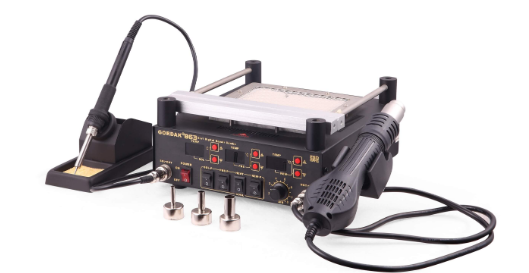Every installation and rework gear should always include some type of preheating station.
Unfortunately, this isn’t usually the case for many people who practice soldering.
In this article, we intend to throw some light on preheating stations, helping you truly understand their advantages, the different kinds of preheater stations that are readily available.
What exactly is a preheating station?
Before we explore the advantages, it is crucial to define the preheating process and its objectives.
For multi-layered installations or huge ground planes, the use of a preheating station is essential to the rework process.
It aids in preventing heat shock and makes the soldering and de-soldering procedure easier.
Whenever a soldering iron is preheated, the temperature of the overall assembly operation gradually rises from ambient temperature to a temperature slightly below the solder melting point.
Thermostatic profiles are used to examine components. This complies with the suggested upper and lower limits for every application.
Advantages of preheating stations
Adjustment of flux
When the soldering iron is pressed to the wire, the flux is the material that melts off.
It is an essential step in the soldering process that aids in preventing oxidation and maintains a solid solder bond.
When flux is activated using a preheating station, the oxides that produce oxidization are cleaned, which improves the wetting process.
Cold solder junctions may arise if the preheat temperatures have become too low as it can reduce the efficiency of flux activation.
Reduces thermal shock
Thermal shock happens when a solitary area of your circuit board heats up quickly and at a rate that is different from the rest of the board.
Because of this, the board may crack and perhaps other components with lesser rates of thermal expansion may crack due to thermo-mechanical stress.
Thermal shocks are decreased by constantly and linearly raising the temperature of your circuit board.
You protect the Circuit Board and the components soldered on it from thermal shock by the gradual application of heat
Components or even the board can start to crack in areas in which thermal shock develops.

Massive ground plane
Large thicknesses (or regions) of copper foil that are attached to the ground point of the circuit are called ground planes.
Where there is a high copper concentration, rework operations may be more challenging and take longer to complete.
This is due to copper’s superior heat conductivity, which allows it to dissipate heat easily.
This reduces the range of conditions in which you can operate at the ideal temperature for soldering application.
The only alternative to preheating is to raise the working temperature, which we do not advise.
By getting around the heat dissipation capabilities of the copper in your Circuit Board, preheating tries to extend the interval of time that the user can use to operate on these ground planes.
Types of preheating Station
Infrared heaters
An infrared preheater’s reduced thermal inertia is its key advantage. With numerous thermocouples ready for monitoring, they quickly respond to heating your intended profile thanks to their high heating capabilities.
These preheaters will warm the board to degrees between 50 and 2500 C by utilizing infrared lights.
The temperature response time is quick enough to be estimated in seconds as opposed to minutes.
Due to the growing use of large mass and lead-free circuit boards, IR preheaters are essential in contemporary soldering.
Users can finish their soldering projects with greater care and accuracy due to Infrared heaters.
Hot Plates
Hot plates are frequently a low-cost or on-budget solution for preheating your boards.
They are made of an iron plate with underside-mounted parallel strip heaters.
These preheaters are best used when the soldering requirements do not change significantly throughout the soldering process.
Preheating Ovens
Preheating oven can produce the perfect homogeneous temperature distributions that most user needs.
The fundamental limitation of Preheating ovens is the inability to do repairs while inside the oven.
Similar to that, after these solder junctions have been in the oven, it is impossible to fast cool them.
Procure top-grade preheating stations from us
Preheating stations provide many advantages, including lower thermal stress, activating the flux, and preventing exposure to molten solder.
Therefore, investing in one will always benefit your assembly process.
Do contact our specialists for more information on preheaters or to further discuss your preheating needs.



